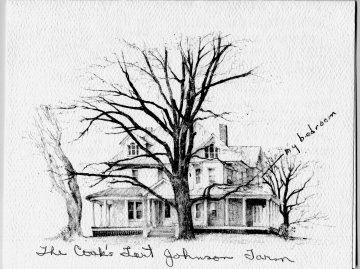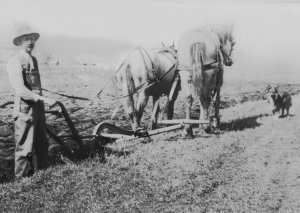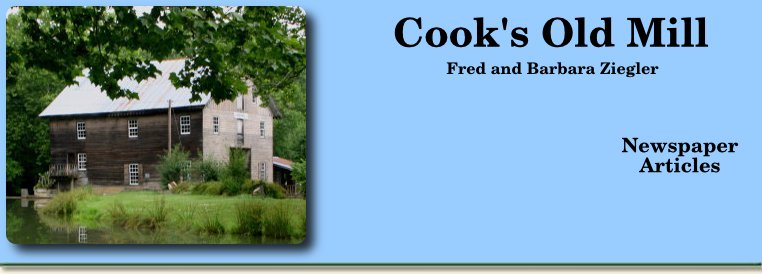Growing up on Cook's Fort Farm
in the 1920s and 30s
Note: The following memories were prepared by Mary K. (Johnson) Dunn who at 86 years old, resides in Roanoke, VA. She grew up in Greenville and submitted these delightful paragraphs in response to my article of Oct. 19th in the Watchman in which I requested stories and photos relevant to Cook's Old Mill. –Fred Ziegler
 My father, J.R.
My father, J.R. Jack
Johnson (John Robert) was born in 1870
in Willow Bend, near Union and died in 1944. The old house is still
there and he used the plans to build the Cook's Fort House near
Greenville about 1907 (corner of Cook's Run and Ellison Ridge Roads)
with the help of a Mr. Miller from Hans Creek. The farm I think
was around 180 to 200 acres, including the site of Cook's Fort
which also extended to the Luther Maddy farm to the west. My
brother Jack and the Larew boys dug up a log which was thought
to be part of the foundation of the fort. Later the Ruritan
Club had gavels made from the wood. The log had survived because
of moisture from the creek underground.
Mr. Johnson was Hell Bent
on getting an education and did,
including time at Athens Normal School. He taught school in
Monroe Co. and his mode of transportation was by horse. An
entrepreneur, he would do anything to better himself. At one
time or another he was Monroe County Sheriff, County Commissioner,
Assessor, business man dealing with livestock, machinery salesman
— anything honorable for a living. He had a great
personality and always seemed to make people laugh. He was a
well respected man.
My father bought Cook's Mill, then called Greenville Roller
Mills, in 1916. He generally engaged others to run the mill
except when things were tough, or when no one was around.
Ordinarily he was out being an entrepreneur, like working for
the state roads picking sites for road stop spots
or
running his animal business. He never let grass grow under
his feet.
In the Mill I remember the big noisy rollers grinding for flour, meal, mash, etc. Dad let me feel the flour which was his way of testing the quality. Wagons, buggies and old trucks came from all around — Hans Creek, Wayside, Kibble Hill, Cook's Run, Ellison Ridge — and they all crossed the ford down from the Mill where Laurel Creek flows into Indian Creek. Shipping points were Talcott or Lowell in Summers Co. where Dad took lambs, cattle, turkeys as well as wool. I often rode behind in a wagon, car or truck as men and dogs drove the sheep to the rail head.
Jack was married twice and he married my mother when he was past fifty and she was half his age. He had seven children by his first wife, Georgia, and two by my mother, Mattie Brown Johnson. I was born in 1920 and Jack, my dearly departed brother came along in 1929. My arrival on this earth was on November 1, the day before the election and the first time women were allowed to vote, and my mother missed it! This was the only time she never got to vote and always regretted it.
My dad bought live stock a season ahead (in VA & WV) and one year the Great Depression was upon us and he ended up mortgaging the farm to pay for cattle when the bottom fell out. He had a business partner in New York, a live stock trader, and he was one of those who jumped to his death when he read the paper one morning in 1929. My father also dealt in wool and sheep. He used the railroad to ship animals to slaughter houses in Chicago and New York. He stored his wool in gunny sacks that reached about 14 feet to the ceiling of the Mill.
 The Depression caused my dad to take a certain portion of the
grain in exchange for grinding it. Customers simply could not
pay and my dad seemed to give away his labor. Everyone around
owed him money. Sometimes he gave my sister and me the books
to write his customers for money with the promises of a nickel
if they paid. Needless to say I don't remember getting any
nickels! In these difficult times my father sold off 66 acres
to Marvin Via for $2500 who got
The Depression caused my dad to take a certain portion of the
grain in exchange for grinding it. Customers simply could not
pay and my dad seemed to give away his labor. Everyone around
owed him money. Sometimes he gave my sister and me the books
to write his customers for money with the promises of a nickel
if they paid. Needless to say I don't remember getting any
nickels! In these difficult times my father sold off 66 acres
to Marvin Via for $2500 who got the best deal of his life
as he figured it.
I was an active child and the Mill was my playground. I would climb to the top of the wool sacks as they accumulated — once an axe followed me down and landed on my big toe — I remember the blood. They bandaged the hanging piece to the toe and covered it with turpentine. It did grow back but I still have the scar.
At one time John and Allie Parker ran the mill. I remember
standing on a chair, plus a Sears catalogue, to reach the wall
phone and I'd ring a long and four shorts, and Mrs. Parker
would answer and I'd say, Parker, come and get me
and
she'd meet me below the Mill and we'd have our afternoon tea,
which consisted of a biscuit with jam and a glass of milk.
When Mr. Parker left he went to Wayside to live with Mrs. Parker
and son Billy until they died.
My sister Ethel married her husband, Earl Mann, when she was 15,
and they ran the Mill. Their two children, Otis (b.1925) and
Patty (b.1938), were born in the Mill House (on present rte.122).
Earl was a good man but not overly ambitious while my sister was
smart as a whip
. They later moved to a farm on Wolf Creek,
near Alderson. Patty now lives in Arkansas and Otis in Detroit.
Ethel, my last sibling, died about two years ago and was buried
in Greenville.
Family members would pay evening visits to the Mill House. I would sleep while the adults played Rook, Canasta, even Bridge! My brother Eddie would put me on his back as we passed the cemetery, the school house, then down the hill between the cedar trees and we'd hit the walking bridge like a herd of horses. Sometimes my sister Sally and I were alone, and as we neared the bridge my brother would make growling noises and no one ever ran faster — across the bridge in a few steps. I now know Dr. Bannister (first to break the 4 minute mile), who was our Doctor in London, and I told him I could run as fast when I was young and believed in ghosts. The bridge had two levels, one central higher than the others to allow for floods. The only way to Greenville was to ford the creek by the Mill, or cross that narrow walk bridge.
The old school was a pillar of the community. The downstairs had a shop on one side and two huge rooms on the first floor that held the Grade School. Upstairs was the High School. A huge auditorium held plays and piano recitals. Teachers were imported and Miss DuBois from Chicago lived in an upstairs room at the Johnson home. She taught piano, voice and theatre. I took all those classes — Wow! I simply cannot carry a note, I can play piano with just one finger, but I act all the time! The building had lots of windows, an automatic stage curtain and my sister Sally was captain of the basketball team in 1926 or '29.
The old school building burned in 1932 and in September we started school anywhere a room could be found in Greenville. Boarders came from all over and they went home on weekends. Felicia Jones from Red Sulphur roomed in the upstairs bedroom of the Mill House. They brought canned meat and veggies from home and lots of eggs from their chicken house. I liked all those older gals. I went home with her on Friday night many times. Miss Jennie Wilson roomed many high school gals and boys. There were no school busses until later years and all sports were held outside. I attended the 7th or 8th grade in Miss Wilson's house. The following year, 1933, we moved into the new school building.
I would be remiss if I didn't mention my mother, Mattie Brown Johnson, never a better woman, well loved by the children, step children and all she came in contact with. She was an angel to all who knew her. I was closer to Sally since she and I were only seven years apart. I was very close to my brother Jack Junior, 9 years younger. I miss them all.
I was married in 1946 to Carl Dunn and we lived in many far away places, including Maracaibo, Tripoli and Benghazi. I still get to Greenville whenever possible to visit friends and relatives. The Johnson family is still going strong in the area and about fifty relatives gather each year along Indian Creek at Mason's Bottom for a family reunion.
Thanks again to Mr. Ziegler for reliving old times
. I believe
we owe a lot to our ancestors, our family, friends and community
for keeping an eye on the past.
Final note: Mary sent a copy of the envelope of a letter she received in 1941 and addressed to her with just the following words: —
Fly away letter at a rapid rate,
To Monroe County in W.Va State,
And there at Greenville you'll find,
Miss Thummie
Johnson, A friend of mine
This was all that was required to get the letter to its destination, and bespeaks of less complicated times!
Published in the Monroe Watchman, February 8, 2007
